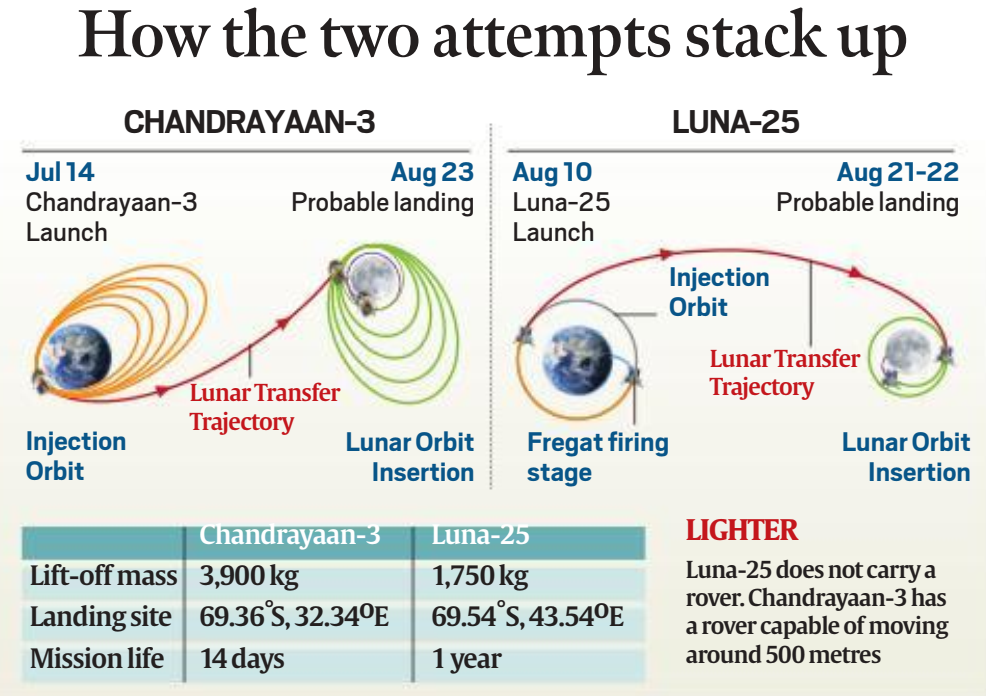India-Russia Moon Mission
- Russia recently launched Luna-25 mission to the moon.
- It is likely to enter the moon’s orbit by August 16 and attempt the soft landing by August 21 or 22
- India also launched Chandrayaan-3 mission to moon which is expected to land on south pole of moon after 23 August 2023.
How is Russia reaching the moon earlier than India?
- Although Luna-25 was launched earlier this week aboard its Soyuz rocket, it will cover the 3.84-lakh-km journey within days.
- This is because the Russian mission was able to follow a more direct trajectory towards the moon, owing to its lighter payload and more fuel storage.
- The lift-off mass for Luna 25 is just 1,750 kg as compared with the 3,900 kg of Chandrayaan-3.
- Chandrayaan’s Lander-Rover alone weighs 1,752 kg, with the propulsion module weighing another 2,148 kg.
- To make up for the lower fuel reserve available on the LVM3 vehicle that launched India’s mission, a more circuitous route was taken.
- After being launched around the Earth, the orbit of the spacecraft was increased in a series of manoeuvres to help it gain velocity.
- Over the next few days, Chandrayaan-3 will reduce its orbit and velocity around to the moon in preparation for the soft landing likely to be attempted on August 23
- Another reason Luna-25 can land a couple of days before India is because the lunar dawn at its landing site will happen earlier.
- One lunar day is equal to 14 Earth days.
- With the payloads being powered by solar panels, landing at the beginning of a lunar day ensures that the experiments get the full 14 earth days.

Difference in the Missions

Apart from being lighter than the Indian mission, Luna-25 does not carry a rover.
- The Russian lander has eight payloads mainly to study the soil composition, dust particles in the polar exosphere, and most importantly, detect surface water.
- The Indian mission also has scientific instruments to study the lunar soil as well as water-ice.
- The location near the southern pole was chosen because of the presence of craters that remain in permanent shadow, increasing the likelihood of finding water-ice.
- Instrument to Chandrayaan-3: The lander will carry four experiments on-board.
- The Radio Anatomy of Moon Bound Hypersensitive ionosphere and Atmosphere (RAMBHA) has a Langmuir probe used to study properties of electrons and ions such as temperature and density. It will study these properties near the surface of the moon and how they change over time.
- The Chandra’s Surface Thermo physical Experiment (ChaSTE) will study the thermal properties of the lunar surface near the polar region. T
- he Instrument for Lunar Seismic Activity (ILSA) will measure the lunar quakes near the landing site and study the composition of the moon’s crust and mantle.
- The LASER Retroreflector Array (LRA) is a passive experiment sent by NASA on-board the mission. LRAs are optical instruments that act as a target for lasers and can be used for very precise tracking by spacecrafts in the lunar orbit
India and the Human lunar mission
- It was the discovery of water molecules by India’s Chandrayaan-1 mission in 2008 that has propelled another race to the moon.
- The United States and China now have plans to take humans to moon again.
- Till date, only 12 men aboard US’ Apollo Missions have set foot on the lunar surface.
- Although India with its limited resources has been able to catch up with countries with more advanced and older space agencies, there is still a long way to go before humans can be sent to the moon.
India and Russia space collaborations
- Many have speculated whether Russia’s launch was targeted for the same time as India’s mission, but Russia dismissed this.
- As, India and Russia have been long-time collaborators, especially when it comes to space activities.
- In fact, Russia was initially supposed to design the lander-rover for India’s Chandrayaan-2 mission.
- However, it withdrew after the failure of its Fobos Grunt mission to one of Mars’ moons.
- This then prompted India to develop the lander-rover independently.
- This is the reason there is a gap of 11 years between the Chandrayaan-1 and Chandrayaan-2 missions.
- Also, the predecessors of the LVM3 that launched Chandrayaan-3 were based on cryogenic engines sold to India by Russia.
- India later developed the technology on its own as Russia did not transfer the technology.
Conclusion
- Therefore, India and Russia missions to moon are sent their respective objectives to carry put moon related study. It will shape the future mission to moon and other celestial body of space.
